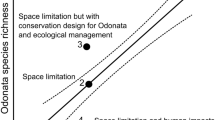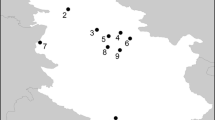Abstract
The increase of human population, especially in urban areas, correlates with an alarming destruction of green spaces. Therefore, understanding the mechanisms by which urbanization processes affect biodiversity is crucial in integrating the environment in a proper urban planning. The main urban center of Argentina is known as the Greater Buenos Aires (GBA), and it includes the autonomous city of Buenos Aires and 24 surrounding districts. Avellaneda, one of the districts of the GBA, is an important urban and industrial center with green areas and low level of urbanization on the coastal area of the Río de la Plata. This paper provides the first Odonata inventory for Avellaneda, determines the species’ level of synanthropy with the Nuorteva index, and assess the Odonata species replacement along a latitudinal gradient on the occidental margin of the Río de la Plata.

Similar content being viewed by others
References
Brown A, Martinez Ortiz U, Acerbi M, Corcuera J (2006) La Situación Ambiental Argentina 2005. Fundación Vida Silvestre Argentina, Buenos Aires, 587p
Clark TE, Samways MJ (1996) Dragonflies (Odonata) as indicators of biotope quality in the Kruger National Park. South Africa J Appl Ecol 33:1001–1012
Clausnitzer V (2003) Dragonfly communities in coastal habitats of Kenya: indication of biotope quality and the need of conservation measures. Biodivers Conserv 12:333–356
Cody ML (1993) Bird diversity components within and between habitats in Australia. In: Ricklef RE, Schluter D (eds) Species diversity in ecological communities: historical and geographical perspectives. The University of Chicago Press, Chicago, pp 147–169, 414 p
Corbet PS (1999) Dragonflies: behavior and ecology of Odonata. Comstock, Ithaca, New York, p 829
De Marco JP, Resende DC (2002) Activity patterns and thermoregulation in a tropical dragonfly assemblage. Odonatologica 31:129–138
Dijkstra KDB, Lempert J (2003) Odonate assemblages of running waters in the Upper Guinean forest. Arch Hydrobiol 157:397–412
Figueroa-Roa L, Linhares AX (2004) Sinantropia de los Calliphoridae (Diptera) de Valdívia, Chile. Neotrop Entomol 31:233–239
Fischer S, Marinone MC, Fontanarrosa MS, Nieves M, Schweigmann N (2000) Urban rain pools: seasonal dynamics and entomofauna in a park of Buenos Aires. Hydrobiologia 441:45–53
Fontanarrosa MS, Torres PLM, Michat MC (2004) Comunidades de insectos acuáticos de charcos temporarios y lagunas de la ciudad de Buenos Aires (Argentina). Rev Soc Entomol Argent 63:55–65
Goertzen D, Suhling F (2013) Promoting dragonfly diversity in cities: major determinants and implications for urban pond design. J Insect Conserv 17:399–409
Instituto Nacional de Estadística y Censos. Censo Nacional de Población, Hogares y Viviendas 2001 y (2010). <http://www.indec.gov.ar/> 15th December 2015.
Marzluff JM, Ewing K (2001) Restoration of fragmented landscapes for the conservation of birds: a general framework and specific recommendations for urbanizing landscapes. Restor Ecol 9:280–292
McKinney ML (2006) Urbanization as a major cause of biotic homogenization. Biol Conserv 127:247–260
Mensah CA (2014) Destruction of urban green spaces: a problem beyond urbanization in Kumasi City (Ghana). AJEP 3:1–9
Mariluis JC, Schnack JA, Muzón J, Spinelli GR (1990) Moscas Calliphoridae y Mesembranellidae de Puerto Iguazú. Composición específica y ecología. (Insecta - Diptera). Graellsia 46:7–18
Mollov IA (2014) Level of synanthropy of the amphibians and reptiles from the city of Plovdiv (Bulgaria). Ecol Balk 6:109–112
Monteiro Junior CS, Juen L, Hamada N (2014) Effects of urbanization on stream habitats and associated adult dragonfly and damselfly communities in central Brazilian Amazonia. Landscape Urban Plan 127:28–40
Monteiro Junior CS, Juen L, Hamada N (2015) Analysis of urban impacts on aquatic habitats in the central Amazon basin: adult odonates as bioindicators of environmental quality. Ecol Indic 48:303–311
Mulieri PR, Patitucci LD, Schnack JA, Mariluis JC (2011) Diversity and seasonal dynamics of an assemblage of sarcophagid Diptera in a gradient of urbanization. J Insect Sci 11:91
Muzón J, Rodrigues Capitulo A, Jurzitza G (1990) Populationsdynamik von Telebasis willinki Fraser, 1948 im Galerie-wald des Río de la Plata bei Punta lara, Argentinien (Odonata: Coenagrionidae). Opusc Zool Flumin 53:1–10
Muzón J, Lozano F, del Palacio A, Ramos LS, Lutz A (2015) Odonata from the Lower Delta of the Paraná River, Argentina. Agrion 20:68–72
Nuorteva P (1963) Synanthropy of blow flies (Dipt. Calliphoridae) in Finland. Ann Entomol Fenn 29:1–49
Nuorteva P (1971) The synanthropy of birds as an expression of the ecological cycle disorder caused by urbanization. Ann Entomol Fenn 8:547–553
Oerteli B (2008) The use of dragonflies in the assessment and monitoring of aquatic habitats. In: Córdoba-Aguilar A (ed) Dragonflies and damselflies: model organisms for ecological and evolutionary research. Oxford University Press, Oxford, pp 79–95
Ringuelet RA (1961) Rasgos fundamentales de la Zoogeografía de la Argentina. Physis 22:151–170
Ronco A, Peluso L, Jurado M, Rossini GB, Salibian A (2008) Screening of sediment pollution in tributaries from the southwestern coast of the Rio de la Plata estuary. Lat Am J Sedimentol Basin Anal 15:67–75
Sacher P (1983) Spinnen (Araneae) an und in Gebäuden. Versuch einer Analyse der synanthropen Spinnen-fauna in der DDR. Entomol Nachr Berl 27:97–204
Schnack JA, Mariluis JC, Muzón J, Spinelli GR (1990) Synanthropy of Calliphoridae. A first approach in Argentina (Insecta, Diptera). Eos 65:273–280
Schnack JA, Mariluis JC, Centeno N, Muzón J (1995) Composición específica, ecología y sinantropía de Calliphoridae (Insecta: Diptera) en el Gran Buenos Aires. Rev Soc Entomol Argent 54:161–171
Simaika JP, Samways MJ (2008) Valuing dragonflies as service providers. In: Córdoba-Aguilar A (ed) Dragonflies and damselflies. Model organisms for ecological and evolutionary research. Oxford University Press, Oxford, pp 109–123, 288 p
Simaika JP, Samways MJ (2009) An easy-to-use index of ecological integrity for prioritizing freshwater sites and for assessing habitat quality. Biodiversity Conserv 18:1171–1185
Valesova-Zdarkova E (1966) Synanthrope Spinnen in der Tschechoslowakei. Senck Biol 47:73–75
Vallvé SL, Rojo H, Wisnivesky-Colli C (1996) Urban ecology of Triatoma infestans in San Juan, Argentina. Mem Inst Oswaldo Cruz 91:405–408
Villalobos-Jiménez G, Dunn AM, Hassall C (2016) Dragonflies and damselflies (Odonata) in urban ecosystems: a review. Eur J Entomol 113:217–232
von Ellenrieder N (2000) Species composition and temporal variation of odonate assemblages in the subtropical-Pampasic ecotone, Buenos Aires, Argentina. Odonatologica 29:17–30
Acknowledgments
We thank Natalia von Ellenerieder for her review of the early version of this manuscript; Mónica Cappellini, Hugo Mosto, and Gustavo Ghiglieri, Municipalidad de Avellaneda, for their valuable assistance during the field work; and Alejandro del Palacio for his help with the maps. This research was supported in part by the Universidad Nacional de Avellaneda under PROAPI 2012.
Author information
Authors and Affiliations
Corresponding author
Additional information
Edited by Wesley AC Godoy – ESALQ/USP
Rights and permissions
About this article
Cite this article
Ramos, L.S., Lozano, F. & Muzón, J. Odonata Diversity and Synanthropy in Urban Areas: A Case Study in Avellaneda City, Buenos Aires, Argentina. Neotrop Entomol 46, 144–150 (2017). https://doi.org/10.1007/s13744-016-0443-5
Received:
Accepted:
Published:
Issue Date:
DOI: https://doi.org/10.1007/s13744-016-0443-5




